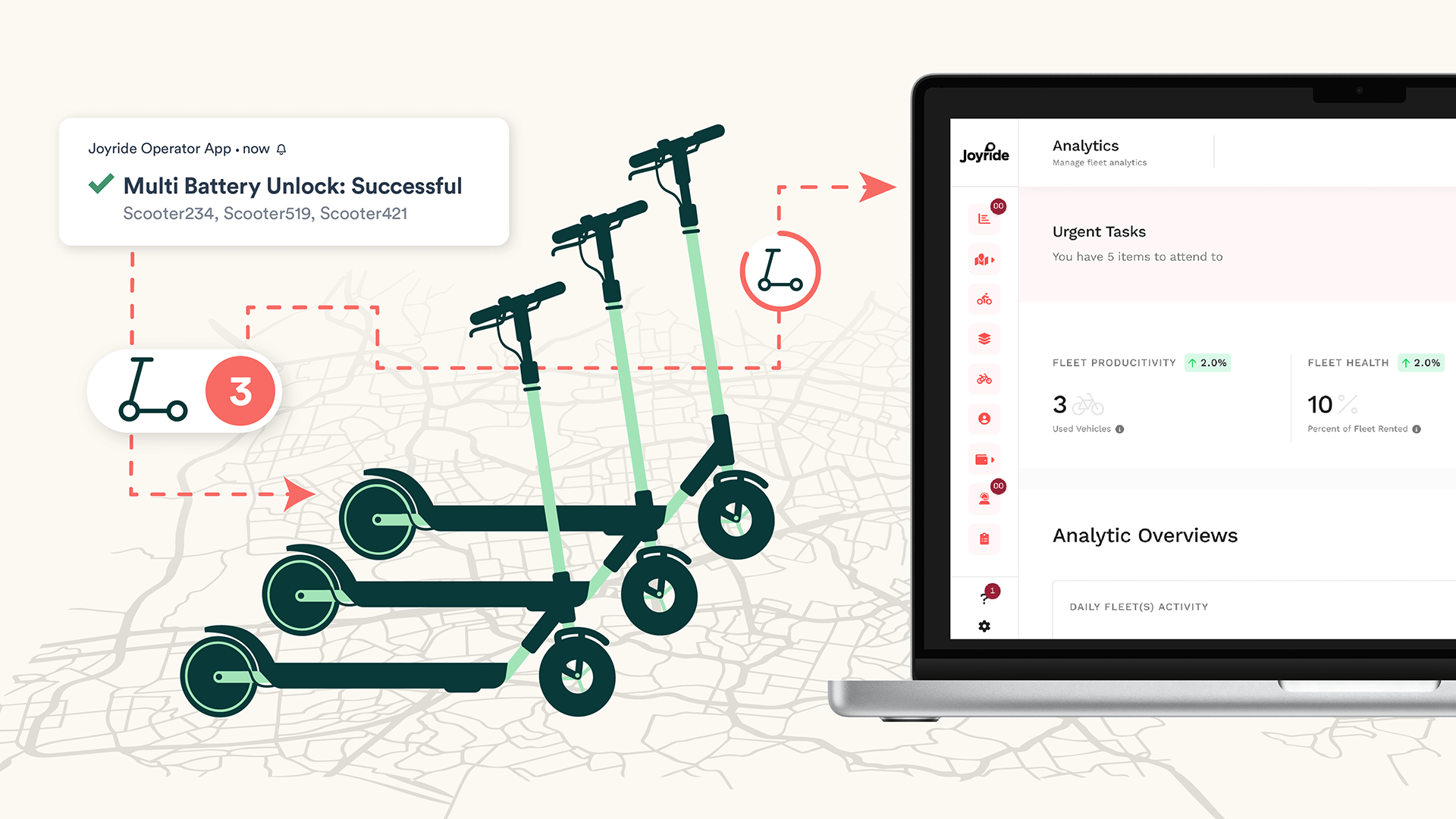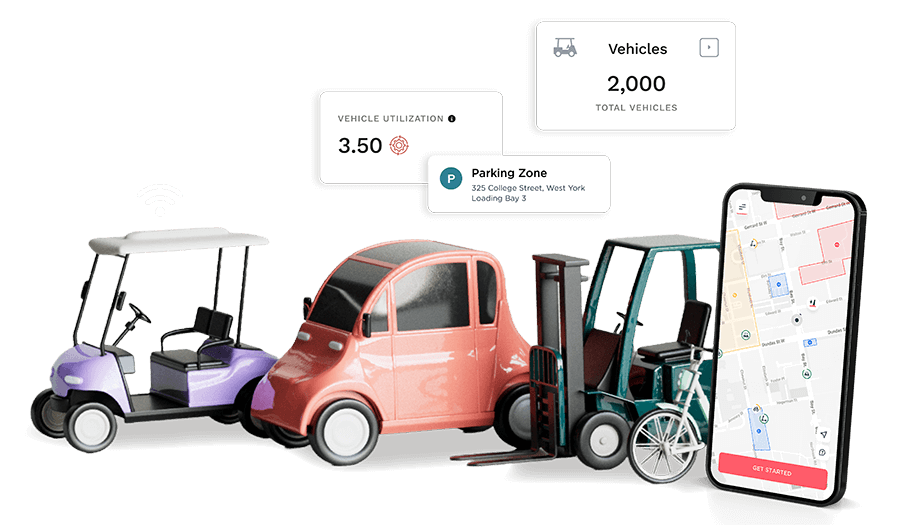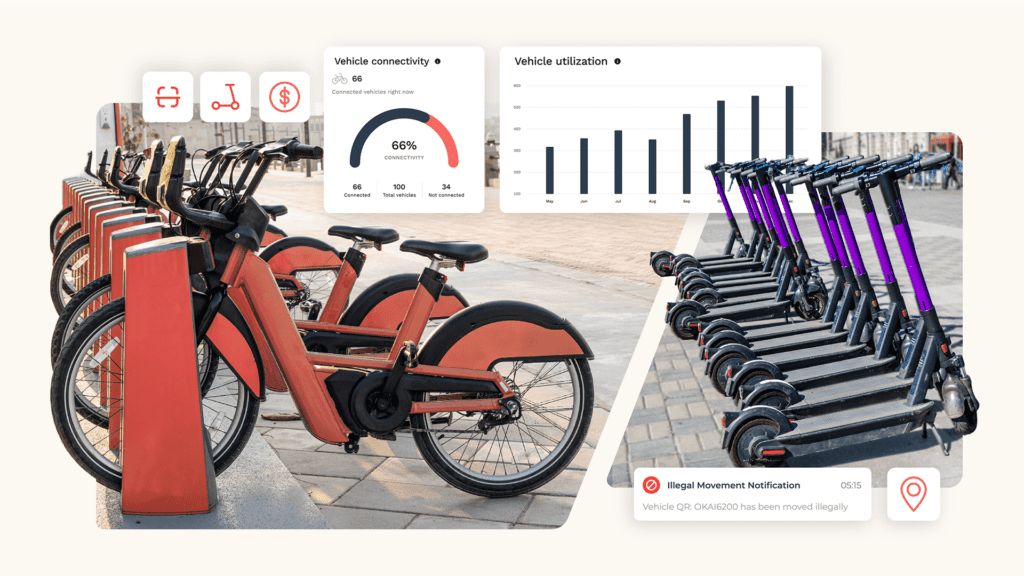A smart-enabled fleet, an intuitive Rider App and sophisticated fleet management software – this cloud technology trifecta makes vehicle sharing possible.
The beating heart of micromobility, though, is on the ground; swapping batteries, repairing tires and transporting vehicles in the most efficient ways possible.
In order for a shared mobility fleet to reach its full potential, it’s important for entrepreneurs to understand which performance metrics to track, and more importantly, how to measure and map those metrics to vehicle rentals, device lifespans and ride revenue.
To celebrate the launch of our Ultimate Scooter-Sharing Business Guide, Joyride Academy is proud to bring you a free lesson in fleet management. Read on to learn why successful shared mobility operators must prioritize efficient fleet management above all else.
What is micromobility fleet management?
Micromobility fleet management is the practice of monitoring and optimizing a fleet of small, lightweight electric vehicles, such as e-scooters, bicycles or e-bikes. While many fleet management tasks can be conducted remotely (such as monitoring usage patterns), the practical application of deploying vehicles strategically, as well as maintaining and charging them, requires at least one fleet manager to be on-site.
What does a fleet manager do?
Though the field team is tasked with charging, repairing and distributing scooters, it’s the fleet manager’s responsibility to manage the system as a whole. Fleet managers must also ensure the field team is equipped with the supplies and systems they need to maximize their productivity.
In a public sharing scenario, this individual may also be responsible for liaising with local governments to ensure compliance with regulations, obtain necessary permits and integrate micromobility services into urban mobility plans.
What tools and technology are used for fleet management?
A common mistake made by new operators is to start out with manual processes. After all, you’re still figuring out where and when to deploy vehicles and how to repair common damages. While creating business systems can feel like extra work (especially when there’s already so much to do), being meticulous about processes and data-tracking from the beginning will give you the best chance at achieving long-term success.
The most important work tool to oversee fleet activity is the backend dashboard. With the help of GPS tracking and sensors onboard the vehicles, fleet managers are able to monitor the location, status and usage patterns of devices. This helps them to strategically distribute scooters or bikes throughout the service area, identify optimal parking or docking locations, and make informed decisions to balance supply and demand.

Additional tools may be used to communicate with the in-field team (Operator App, Slack, WhatsApp, WeChat), plan geofencing (Google MyMaps, Map Hub), report to the city (Ride Report, Fluctuo) or to extract and analyze the data needed to optimize task assignment (Keplr.gl, Zoba, Anadue).
Which metrics are important for fleet management?
Micromobility fleet managers use various criteria to track fleet health, improve vehicle deployments, enhance user experience and ensure the economic sustainability of the operation.
Here are some common performance metrics used by e-scooter and bicycle fleet managers:
Vehicle Utilization Rate measures the percentage of time that fleet vehicles are actively being used by riders. High utilization indicates that vehicles are in demand and well-deployed. This metric can be expressed in two ways:
Vehicle Idle Time is the duration a vehicle remains stationary and unused between rides. Examining the idle periods of a specific vehicle throughout the day can reveal where deployments can be improved.
For example, if a scooter is ridden once around 9AM, and again at 5PM, it spends a period of eight hours idle. Following that first ride, if it is possible to rebalance the scooter to a location where it yields multiple follow-on rides, idle time is decreased and utilization increases in turn.
Rebalance Rate measures the frequency of touchpoints needed to move fleet vehicles from areas of low demand and redistribute them throughout the service area. A high rebalance rate with a low utilization rate indicates ineffective fleet management. A low rebalance rate paired with a high utilization rate usually indicates that fleet vehicles are deployed in locations with consistent two-way demand (these areas are your golden geese – nurture them!)
Vehicle Downtime measures the time vehicles are offline due to charging, transportation, repairs, or any issues with IoT connectivity. Reducing downtime is crucial for maximizing fleet utilization.
Maintenance Downtime is the most tangible metric for fleet management in the warehouse. By tracking the number and nature of maintenance requests, fleet managers can identify common issues and build processes to expedite turnaround.
Average Trip Duration indicates the average length of a single ride. It can be useful to correlate temporal trends with origin and destination points. For example, short trips from public transit stops to commercial areas might suggest high demand for last-mile transportation. Longer trips with more dispersed endpoints could indicate leisure use.
Average Distance Traveled calculates the average mileage riden by users. Duration and distance do not always align as expected. For example, a tourist on an e-scooter might make frequent pauses for photo-ops, covering less ground in the same time it takes another rider to get to a further destination.
Battery Status of fleet vehicles must be tracked to ensure that they have enough charge for user trips. Rider demand and fleet size will dictate how frequently batteries must be swapped, which will affect other metrics such as charge cycles, battery lifespan, vehicle interactions and rebalancing routes.
Vehicle Churn is the number of lost and decommissioned vehicles within a given time period. Well-cared for fleet vehicles and batteries should last several years, however, the churn-rate of a fleet is subject to external factors such as theft and vandalism. Fleet managers should take every precaution with geofencing to prohibit parking near bodies of water, and map off any major risk areas as no-ride zones.
Rider Ratings and Feedback can be a valuable data point for fleet managers to identify issues with the rider experience. App ratings, social media comments, and support tickets all provide insight into user satisfaction and issues which may be minimized with proactive and self-serve support.
Financial Performance metrics, such as revenue per day, revenue per vehicle, asset depreciation and profit margins, help assess the financial health of a micromobility operation. Monitoring customer acquisition costs and retention rates, market penetration and user engagement are important gauges of the success of marketing efforts – perhaps outside of the purview of a fleet manager, but important to mention nonetheless.
Regulatory Compliance metrics include anything related to compliance with local bylaws, permit conditions (such as equity zones), and any penalties incurred for parking or permit violations.
Why is micromobility fleet management important?
Fleet efficiency is about moving vehicles where they’re needed, swapping batteries before they’re depleted, and ensuring that every software innovation aligns to provide riders with a dependable, and satisfying transportation experience. In order for fleet managers to make data-driven decisions, they need best-in-class software and communication tools which support their team in the field.
There’s no shortage of metrics to explore and improve, but the key takeaway is this: efficient fleet management relies on data.
Scoot to Success with the Ultimate Scooter Sharing Business Guide
Interested in launching your own fleet, but don’t know where to begin? Or want to brush up on the latest industry trends to maximize your fleet’s viability?
In the Ultimate Scooter Sharing Business Guide, we’ve packed everything you need to know about scooter sharing into a single, digestible learning course.
Each lesson is recorded as an audio format, but unlike a podcast or university lecture, we’ve included a multimedia companion with text, images and lots of links to additional resources. From permits and deployments, to sourcing the right vehicles, to making it all work with smart mobility software – you can master micromobility business fundamentals in less than three hours.







